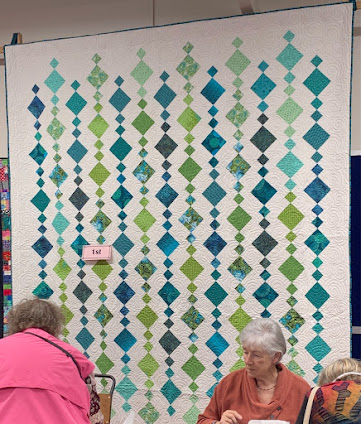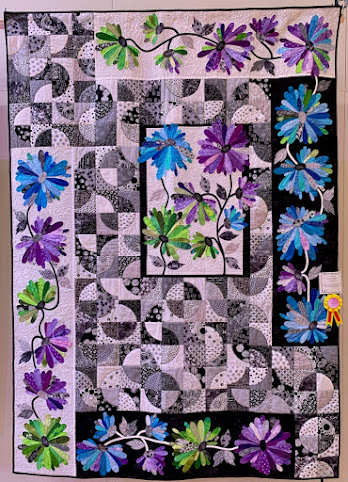Wednesday, September 1, 2021
Single fold mitred quilt binding
Wednesday, April 7, 2021
Thoughts and Stitches from my Studio
Hello neglected blog readers!
I have some big news that some of you may not have heard, the family and I are moving to the South Island. I wrote an email newsletter and in it I tell a bit more about what's happening.
If you'd like to read it, click here.
The reason this poor blog has been neglected for so long is many fold. One of them is that I intend to (finally! Talk about procrastination!) get my own website up and running, and then I'll have a blog on there. So anything I write here, I keep thinking I should save it and write there, it's just that there hasn't happened quite yet. So in the meantime, I'll be writing a monthly email newsletter with thoughts and stitches (rambling words and a few pretty pictures of my work) from my studio. I'd love you to join me in the conversation, you can sign up to receive my email newsletter by clicking here.
The next big thing on my calendar is presenting at the SAQA virtual conference in about 10 days time.
I'm part of a panel presentation and discussion called 'Art from Oceania'. So if you are a SAQA member, and have signed up for the conference, I'd love to see you there!
And then the NEXT big thing for me is the Great New Zealand Quilt Show, being organised by Aotearoa Quilters. I'm on the committee so have been working away to help bring you this in-person, in-real-life, fingers-crossed-covid-stays-away, three day quilt show. If you are in NZ, you should try and get along, it'll be awesome!
So that's it for me today. I better get back to packing up my studio. Happy stitching!
PS - Don't forget to sign up for my newsletter!
Saturday, October 24, 2020
Lint is a fact of life.
I've just come back from a quick tour of New Zealand with the BERNINA team, launching the new Q16 sit-down longarm quilting machine. One of our frequent topics of discussion was lint and machine cleaning.
So here's a picture of the inside of the bobbin area after a three hour class. The stitch plate isn't on, that's why it's brighter. But check out the lint! And we were using good quality batting, fabrics and threads.
Lint is a fact of life! When you sew with fibres, especially on a high-speed machine, you are going to get lint. Your job isn't to try and find the least linty products to use, your job to clean your machine.
Make it part of your sewing routine. Sit down to sew, pop open your machine and give it a quick swipe with your lint brush. The more often you do it, the less time it will take. And while you are there, give it a drop of oil as per your instruction manual. You really should be giving it an oil every 4-8 hours of sewing time.
And I guess now is a good time to remind you to change your needle too. Every eight hours of sewing!
Your time is valuable, set yourself up for a good days sewing. You've spent plenty of money on your machine and on your fabrics, you've given up your valuable time to your project, so don't skimp on those couple of minutes it will take to clean and oil your machine so that you can have a well-running machine that will be a joy to sew with.
Happy quilting!
Wednesday, September 23, 2020
Whangarei Quilt Exhibition 2020
Wednesday, September 9, 2020
Teaching Tour - the new BERNINA Q16
In my last blog post I hinted that there was an upcoming teaching tour with BERNINA. It's all confirmed so now I can give you all the deets and make it all official and stuff.
BERNINA have released a brand new machine. It's another sit down long-arm with all the great features of the BERNINA Q20 but it's just a little smaller. Welcome to the new BERNINA Q16! This is perfect for those quilters who need more throat space than a domestic to make quilting their quilts a breeze, but don't have quite enough sewing room space for the larger machines. It's also just a bit easier on the budget.
And I'm so excited to be able to help BERNINA introduce it to New Zealand!
BERNINA asked me to design a fabric panel specifically for this class. I've used my own hand-dyed fabrics and put together a design that isn't too complicated but still has plenty of scope to get creative with the quilting designs. Rebecca Owen from BERNINA worked her digital magic and put the squared border around it and has got a panel printed for every workshop participant.
You'll be able to try out free-motion and ruler quilting on the beautiful Q16 machine and will get to take your very own ruler home with you - as well as your quilted sample of course. The panel will be sandwiched, the machines will be threaded, all you have to do is sit down and have a creatively fun time with me and the BERNINA crew!
It's a great opportunity to have a really good try out session with the Q16. I know it can be a bit overwhelming at a show with everyone watching and other people waiting to have their turn too. At this workshop every class participant will have their own machine and during the three hours I'll be able to guide you through some beautiful free-motion and ruler quilting designs, which you can combine to really make the panel your own.
If you are interested in joining us, please get in touch with your local BERNINA dealer. I look forward to seeing you there, it's going to be so much fun!
Edited to add the timetable:

















































